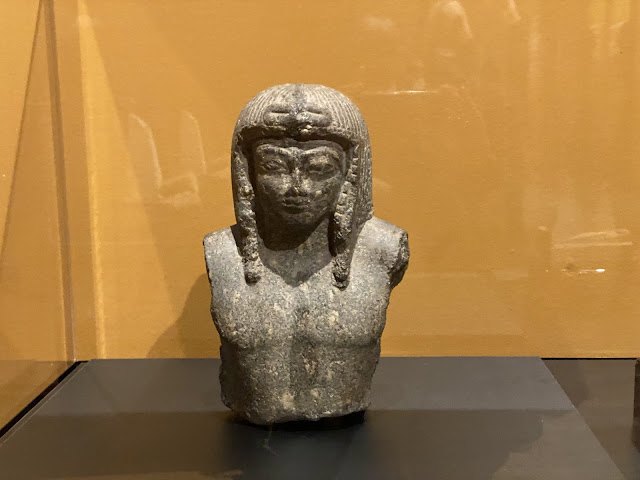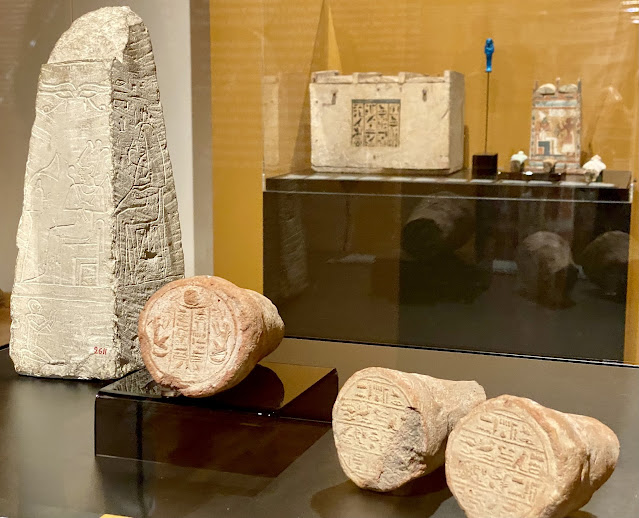"Greetings to you, O Nile, who came out of the earth, who came to Egypt Live! ... Bringer of nourishment, rich in food, creator of all good things..."
Hymn to the Nile
Conegliano - Palazzo Sarcinelli
Egypt: Journey Towards Immortality
The exhibition Egypt: Journey Towards Immortality at Palazzo Sarcinelli in Conegliano - a stone's-throw from Venice - curated by - Egyptologist Maria Cristina Guidotti - until April 6 - organized by - ARTIKA - showcases over 100 artifacts—including mummies, sculptures, and funerary items—from the Museo Archeologico Nazionale di Firenze. The exhibition highlights the Egyptians' complex beliefs and practices around death and the afterlife, inviting visitors to explore the rites, spirituality, and enduring allure of the pharaohs and their quest for immortality.
Coffin of priest Padihorpakhered - Foreground - 775-656-BCE
Coffin of Priest Padimut - 1070-664-BCE
In Ancient Egypt, death was seen not as an end but as a transition to an eternal afterlife. For the soul to reach immortality, it needed to be reincarnated in its own body, which had to be preserved forever. This belief spurred the development of advanced embalming techniques and the custom of placing objects in tombs to magically sustain the soul in the afterlife. All these funerary practices focused on preservation for the afterlife, not merely in death.
Mummy of a Woman - Roman Period 1st-2nd-century-CE
Funerary Stele of Pendu - 664-332-BCE
Anna Consonni, Museo Archeologico Nazionale di Firenze
the soul's journey towards the afterlife..."
Small box with a set of 28 Shabti - 664-332-BCE
Bas-relief with the goddess Imentet - 1291-1185BCE
Shabti of Iriru - 656-332a.C
Shabti of Hathoremheb - 1550-1070-BCE - Shabti of Huya -1550-1070-BCE
“Osiris, lord of eternity, he who is at the head of the westerners. For the ka of Osiris, scribe of the temple of Montu, Nekhtramontu, justified, privileged.”
Statuette of a concubine of the dead - 1550-1070-BCE
Statue of Ptah-Sokar-Oris - 664-332-BCE
Three Funerary Cones of Montuemhat - 775-525-BCE
Daily Life Objects in the Funeral Equipment
To enable the deceased's soul to live on after death, it required its body and all essentials from earthly life—food, drink, clothing, and pleasures. Tombs were stocked with abundant provisions, furniture, clothes, valuables, and personal items. To ensure the deceased’s needs were met, Egyptians depicted offerings, daily environments, and life’s pleasures on tomb walls, believing these scenes would magically revive with the help of hieroglyphic spells and names carefully inscribed alongside the images.
Small Cosmetic Bowl - 2323-2152BCE - Kohl Tube - 1150-1070-BCEKohl Jar - 1150-1070-BCE - Small Cosmetic Bowl - 664-332-BCE
Selfie Corner
Anna Consonni, Cristina Sardi, Elena Zannoni, Maria Cristina Guidotti, Daniel Buso, Fabio Chies and Olga Rilampa
















